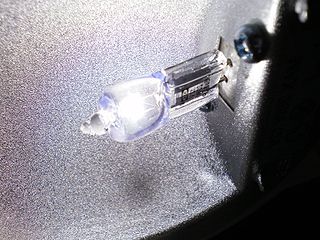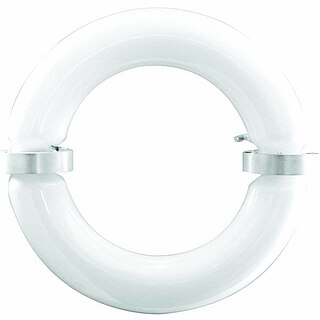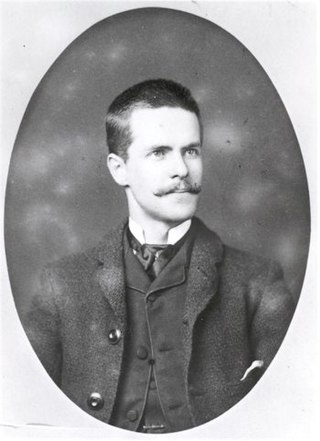
An electric light, lamp, or light bulb is an electrical component that produces light. It is the most common form of artificial lighting. Lamps usually have a base made of ceramic, metal, glass, or plastic which secures the lamp in the socket of a light fixture, which is often called a "lamp" as well. The electrical connection to the socket may be made with a screw-thread base, two metal pins, two metal caps or a bayonet mount.

Thomas Alva Edison was an American inventor and businessman. He developed many devices in fields such as electric power generation, mass communication, sound recording, and motion pictures. These inventions, which include the phonograph, the motion picture camera, and early versions of the electric light bulb, have had a widespread impact on the modern industrialized world. He was one of the first inventors to apply the principles of organized science and teamwork to the process of invention, working with many researchers and employees. He established the first industrial research laboratory.

An incandescent light bulb, incandescent lamp or incandescent light globe is an electric light with a filament that is heated until it glows. The filament is enclosed in a glass bulb that is either evacuated or filled with inert gas to protect the filament from oxidation. Electric current is supplied to the filament by terminals or wires embedded in the glass. A bulb socket provides mechanical support and electrical connections.

A halogen lamp is an incandescent lamp consisting of a tungsten filament sealed in a compact transparent envelope that is filled with a mixture of an inert gas and a small amount of a halogen, such as iodine or bromine. The combination of the halogen gas and the tungsten filament produces a halogen-cycle chemical reaction, which redeposits evaporated tungsten on the filament, increasing its life and maintaining the clarity of the envelope. This allows the filament to operate at a higher temperature than a standard incandescent lamp of similar power and operating life; this also produces light with higher luminous efficacy and color temperature. The small size of halogen lamps permits their use in compact optical systems for projectors and illumination. The small glass envelope may be enclosed in a much larger outer glass bulb, which has a lower temperature, protects the inner bulb from contamination, and makes the bulb mechanically more similar to a conventional lamp.

Henry Woodward was a Canadian inventor and a major pioneer in the development of the incandescent lamp. He was born in 1832.

Sir Joseph Wilson Swan FRS was an English physicist, chemist, and inventor. He is known as an independent early developer of a successful incandescent light bulb, and is the person responsible for developing and supplying the first incandescent lights used to illuminate homes and public buildings, including the Savoy Theatre, London, in 1881.

A fluorescent lamp, or fluorescent tube, is a low-pressure mercury-vapor gas-discharge lamp that uses fluorescence to produce visible light. An electric current in the gas excites mercury vapor, which produces short-wave ultraviolet light that then causes a phosphor coating on the inside of the lamp to glow. A fluorescent lamp converts electrical energy into useful light much more efficiently than an incandescent lamp, but is less efficient than most LED lamps. The typical luminous efficacy of fluorescent lighting systems is 50–100 lumens per watt, several times the efficacy of incandescent bulbs with comparable light output. For comparison, the luminous efficiency of an incandescent bulb may only be 16 lumens per watt.
Within the context of a national or multilateral body of law, an invention is patentable if it meets the relevant legal conditions to be granted a patent. By extension, patentability also refers to the substantive conditions that must be met for a patent to be held valid.
The Phoebus cartel was an international cartel that controlled the manufacture and sale of incandescent light bulbs in much of Europe and North America between 1925–1939. The cartel took over market territories and lowered the useful life of such bulbs, which is commonly cited as an example of planned obsolescence.

The induction lamp, electrodeless lamp, or electrodeless induction lamp is a gas-discharge lamp in which an electric or magnetic field transfers the power required to generate light from outside the lamp envelope to the gas inside. This is in contrast to a typical gas discharge lamp that uses internal electrodes connected to the power supply by conductors that pass through the lamp envelope. Eliminating the internal electrodes provides two advantages:

Tungsram was a manufacturing company located in Hungary and known for their light bulbs and electronics. Established in Újpest in 1896, it initially produced telephones, wires and switchboards. The name "Tungsram" is a portmanteau of tungsten and wolfram, the two common names of the metal used for making light bulb filaments. Before becoming nationalized by the Communist government in 1945, the company was the world's third largest manufacturer of light bulbs and radiotubes, after the American General Electric and RCA companies.

A bubble light is a decorative device consisting of a liquid-filled vial that is heated and illuminated by an incandescent light bulb. Because of the liquid's low boiling point, 39.6°C (103.3°F), the modest heat generated by the lamp causes the liquid to boil and bubble up from the vial's base thus creating a decorative effect.

Mazda was a trademarked name registered by General Electric (GE) in 1909 for incandescent light bulbs. The name was used from 1909 to 1945 in the United States by GE and Westinghouse. Mazda brand light bulbs were made for decades after 1945 outside the US. The company chose the name due to its association with Ahura Mazda, the transcendental and universal God of Zoroastrianism, whose name means light of wisdom in the Avestan language.

Edison screw (ES) is a standard lightbulb socket for electric light bulbs. It was developed by Thomas Edison (1847–1931), patented in 1881, and was licensed in 1909 under General Electric's Mazda trademark. The bulbs have right-hand threaded metal bases (caps) which screw into matching threaded sockets. For bulbs powered by AC current, the thread is generally connected to neutral and the contact on the bottom tip of the base is connected to the "live" phase.

The Centennial Light is an incandescent light bulb, recognized as the oldest known continuously operating light bulb. It was first illuminated in 1901, and has only been turned off a few brief times since. It is located at 4550 East Avenue, Livermore, California, and is open to public viewing. Due to its longevity, the bulb has been noted by The Guinness Book of World Records, Ripley's Believe It or Not!, and General Electric. The light has been the subject of many TV shows and news reports along with at least 4 books, and has its own website.

A bipin or bi-pin is a type of lamp fitting. They are included in the IEC standard "IEC 60061 Lamp caps and holders together with gauges for the control of interchangeability and safety". They are used on many small incandescent light bulbs, and for starters on some types of fluorescent lights.
United States v. General Electric Co., 272 U.S. 476 (1926), is a decision of the United States Supreme Court holding that a patentee who has granted a single license to a competitor to manufacture the patented product may lawfully fix the price at which the licensee may sell the product.
Electron-stimulated luminescence (ESL) is production of light by cathodoluminescence, i.e. by a beam of electrons made to hit a fluorescent phosphor surface. This is also the method used to produce light in a cathode ray tube (CRT). Experimental light bulbs that were made using this technology do not include magnetic or electrostatic means to deflect the electron beam.

William Joseph Hammer was an American pioneer electrical engineer, aviator, and president of the Edison Pioneers.

Edison light bulbs, also known as filament light bulbs and retroactively referred to as antique light bulbs or vintage light bulbs, are either carbon- or early tungsten-filament incandescent light bulbs, or modern bulbs that reproduce their appearance. Most of the bulbs in circulation are reproductions of the wound filament bulbs made popular by Edison Electric Light Company at the turn of the 20th century. They are easily identified by the long and complicated windings of their internal filaments, and by the very warm-yellow glow of the light they produce.
















